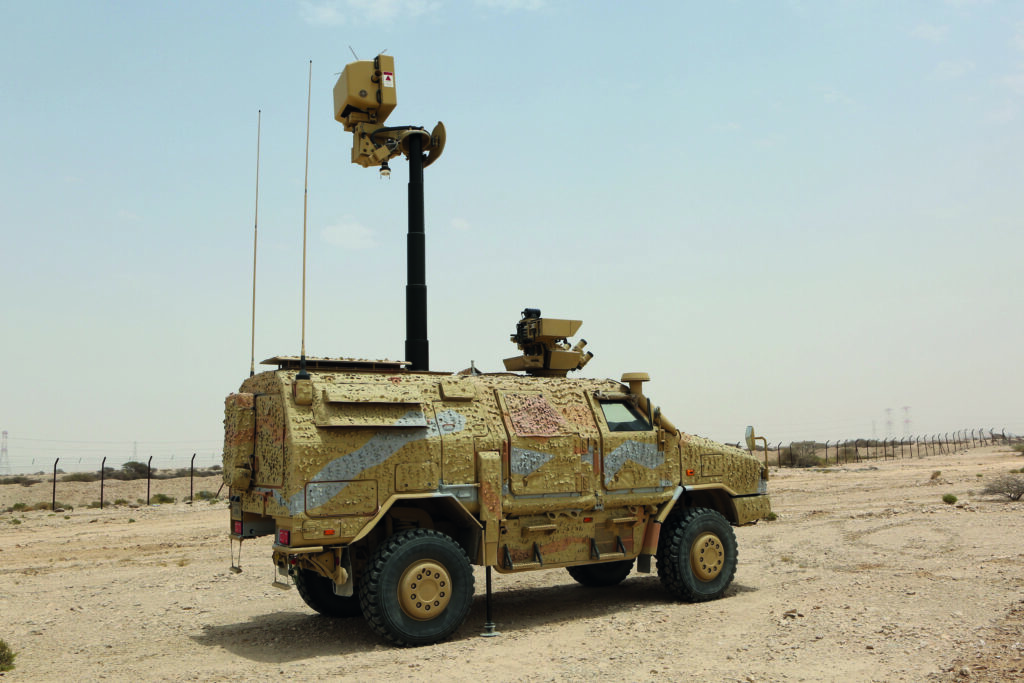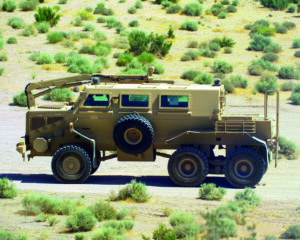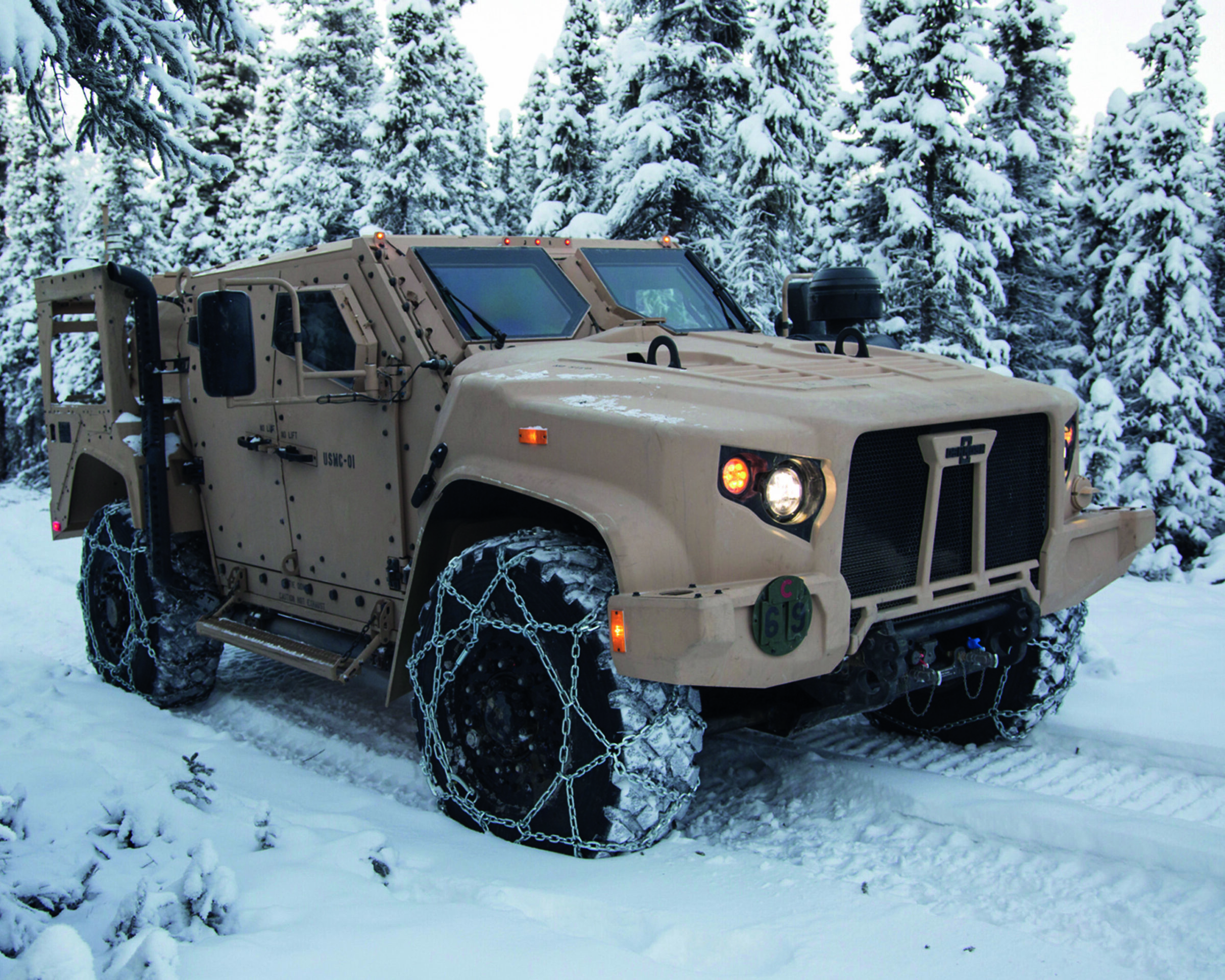Mine-Resistant Ambush-Protected (MRAP) vehicles are designed to mitigate the effects of both buried mines and Improvised Explosive Devices (IED), with the intent of maximising both vehicle and occupant survival. This is achieved through a combination of features usually including a monocoque design incorporating the cockpit and passenger sections, and sometimes the engine compartment; underbody and side armour (which also provides protection against conventional threats such as small arms ammunition and rocket-propelled grenades); high ground clearance; a v-shaped underbody to deflect the energy of mines and explosive charges; and blast attenuating seats outfitted with five-point harnesses.
Birth of a New Vehicle Class
Development of the MRAP class of vehicles has its roots in the post-invasion occupation of Iraq. US Army and US Marine Corps (USMC) patrols, in particular, began incurring significant casualties when buried and roadside charges destroyed unarmoured and conventionally armoured light tactical vehicles such as HUMVEES. By late 2003, the Pentagon began looking for vehicles designed to meet the new threat.
As early as the 1970s the Rhodesian and South African armed forcers had introduced mine resistant vehicle designs. These became the basis for the MRAP vehicle concept. San Diego based Force Protection, Inc. (FPI, acquired by General Dynamics Land Systems or GDLS in 2011) presented the first MRAP design, dubbed the COUGAR, to the USMC in 2004. Results were impressive. By the end of that year the Marines reported over 300 IED incidents involving COUGARS; not a single service member was killed. Soon several variants were introduced, based on both 4×4 and 6×6 chassis, optimised for roles such as engineering, Explosive Ordnance Disposal (EOD), protected patrol, and fire support.

By 2007 the US Department of Defense initiated a joint-service MRAP programme to develop and procure a greater variety of protected vehicles. The programme officially ran through 2012 and resulted in the procurement of nearly 28,000 units, with the majority going to the land forces. The vehicles fell into three categories based on size and function:
- MRAP-MRUV (Mine-Resistant Utility Vehicle), the smallest and lightest category which included the COUGAR 4×4, NaviStar MaxxPro, and BAE Systems CAIMAN 4×4, procured for urban operations;
- MRAP-JERRV (Joint EOD Rapid Response Vehicle) which, despite the designation, was also used for convoy duty, troop transport, engineering and field ambulance service. Procured models included the GDLS RG-31E and the COUGAR 6×6 variant;
- The third and largest category included only one type, the GDLS – Force Protection BUFFALO MRV used for IED and mine-clearing.

Son of MRAP
While MRAPs were largely deemed successful in protecting occupants from IEDs (which may have ultimately discouraged IED deployment), they had drawbacks. They were much larger and heavier than conventional vehicles of similar capacity, limiting mobility on damaged roads and bridges; the high centre of gravity increased the risk of rollover; and high fuel consumption imposed logistical burdens.

For this reason, US forces began to significantly reduce their MRAP inventories when forces were drawn down in Iraq and Afghanistan, while retaining a sufficient inventory to meet future requirements. The US Army, for its part, currently maintains two MRAP variants, the MaxxPro family of vehicles and the Oshkosh MRAP All-Terrain vehicle (M-ATV). Both variants are 4×4 configurations, with circa 1,800 kg payload capacity and circa 500-600 km range. Combat weight, without add-on armour, runs between15,000-22,000 kg. Both variants have been upgraded since 2017 to extend service life and enhance performance. The MaxxPro family includes a stretched-wheelbase variant used as an ambulance, and the MaxxPro Dash, a lighter, smaller and more mobile variant of the MaxPro family. The M-ATV is available in five mission-optimised configurations: armed assault, special forces, command vehicle, engineering vehicle and utility transport.
Meanwhile the US Army and the USMC are procuring the Joint Light Tactical Vehicle (JLTV) in large numbers. They will eventually replace a major percentage of the current HUMVEE fleets (100 per cent in the USMC’s case). The JLTV is a direct derivative of the Oshkosh L-ATV, the lighter-weight sister of the M-ATV. The JLTV itself incorporates major aspects of the MRAP concept, including the TAK4i independent suspension system and a v-shaped hull to deflect blast energy from mines or IEDs. Oshkosh states that the multi-mission vehicle, which comes in a number of configurations, offers the same level of protecting as the MRAP, while exceeding the manoeuvrability of the HUMVEE.
European MRAP Success Stories

Of course, MRAPs are not only a US phenomenon. European partners – especially those engaged in Afghanistan and Iraq – soon recognised the utility of the new vehicles. By 2006 the UK was procuring COUGAR variants dubbed the RIDGEBACK and MASTIFF for service as protected patrol vehicles. Seven more European partners and Canada also procured the COUGAR, and other MRAP models, in the following years. Increasingly these were European-designed and produced vehicles.
These include the lightweight OCELOT MRAP (fielded in 2012 by the British Army as the FOXHOUND) which has been marketed by GDLS-UK since 2011. The dismountable crew pod enables the vehicle to be optimised for multiple tasks including troop carrier, armed reconnaissance, command and control, and utility cargo carrier. The UK armed forces are exploring upgrades and innovations to keep the FOXHOUND relevant in years to come. In August 2020 GDLS-UK announced a contract by NP Aerospace, under the UK Ministry of Defence Protected Mobility Fleet Vehicle Programme, to demonstrate an electric-drive (e-drive) FOXHOUND vehicle. According to the firm, the base vehicle already features an architecture that enables electrification; demonstration of the e-drive FOXHOUND is expected in early 2021.
Another European success story is the KMW DINGO. The heavily armoured 4×4 DINGO 2 MRAP is based on a Unimog chassis but adds a v-shaped underbody. Depending on configuration, it can accommodate up to eight troops. The DINGO 2 was introduced as a demonstrator in 2003 and entered service with the German armed forces (Bundeswehr) in late 2004. It has been used extensively in Afghanistan where, according to the German armed forces, the DINGO has saved more service members’ lives than any other tactical vehicle in the Bundeswehr inventory. Building on this positive experience, KMW has designed a larger, heavier 6×6 variant designated the DINGO 3. This 20 tonne 6×6 vehicle boasts an additional five tonnes in payload capacity and accommodates up to 12 troops.

KMW introduced an even heavier MRAP, the 25 tonne GFF4 (Geschütztes Führungsfahrzeug, Protected Command Vehicle) in 2007. The vehicle was designed in cooperation with Italy’s IVECO, which supplied the chassis. Also available as an ambulance and as an emergency and utility vehicle, the GFF4 combines excellent mobility with a very high level of occupant protection. It remains in service with the German armed forces and, as the VTMM (Veicolo Tattico Medio Multiruolo; Medium Multirole Tactical Vehicles), with the Italian Army.
Export Potential

MRAPs are in demand globally, including in nations without the requisite production base.
North American and European manufacturers have developed steady export opportunities.
Globally, NaviStar Defense’s MaxxPro family of vehicles is one of the most successful MRAP series, with vehicles acquired by the armed forces in 28 European, Asian or Middle Eastern nations. General Dynamics Land Systems’ international marketing includes the BUFFALO Mine Protected Clearance Vehicle (MPCV). Widely regarded as the leading protected vehicle for route clearance missions, the BUFFALO MRAP is fielded by the United States, Canada, the UK, France and Italy.
GDLS also internationally markets the South African designed RG-31 family of vehicles, which includes numerous variants including the AGRAB 120mm mortar carrier operated by the UAE. The versatile RG-31 Mk5 can be configured for seven different applications including combat engineering, surveillance vehicle, ambulance or armoured personnel carrier (capacity 4-10 depending on configuration). The RG-31 family is operated by 15 nations, roughly half of them in Africa.

French producers are also strongly represented on the global export market. The Arquus BASTION, to name just one vehicle, has been sold to 17 nations, mostly in Africa. The BASTION’s heavier sister, the 14.5 tonne FORTRESS Mk 2 armoured personnel carrier, was launched in 2020 and is also expected to perform well on the international market. In Europe, it is under consideration for a major Polish Army acquisition programme.
Expanded Horizons
In addition to military applications, MRAP vehicles are used by humanitarian organisations to protect relief workers from mines and other forms of attack. They also serve with law enforcement and domestic security agencies. This trend began in the United States where surplus military equipment is frequently transferred to federal, state and local police agencies. Here, MRAPs are most often used by anti-terrorism /hostage rescue/SWAT (Special Weapons And Tactics) teams. The formerly military vehicles normally require a refit to eliminate purely military features such as weapon turrets. US civilian federal agencies have also deployed MRAPs to rescue hurricane and flood victims who could not be reached by conventional vehicles.

Some European manufacturers are also offering MRAP variants to domestic security and police agencies. The newest capabilities package for the British Army’s FOXHOUND MRAP enables its deployment in the public order role. France’s Nexter, for its part, is offering the 6×6 TITUS (Tactical Infantry Transport & Utility System) – which comes in an impressive variety of military configurations including as a counterinsurgency vehicle and 120mm mortar carrier – and in several civilian variants as well. These include a homeland security/police assault model currently used by the French national police’s RAID (Recherche, Assistance, Intervention, Dissuasion or “Search, Assistance, Intervention, Deterrence”) special tactics unit, and the TITUS WCT “Water Cannon Truck” for riot control.
The Renault (now Arquus) HIGUARD also serves with French police units as well as with internal security forces of two Middle Eastern nations.
Overall, given the continued military requirement and the evolution of alternative civilian applications, continued development and production of MRAPs seems assured for years to come.
Sidney E. Dean



